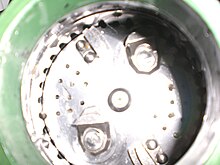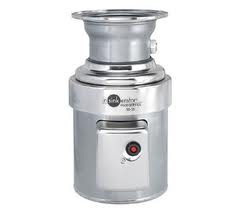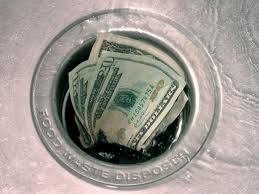Garbage Disposal
Garbage Disposal Or waste disposal unit is a device, usually electrically powered, installed under a kitchen sink between the sink’s drain and the trap which shreds food waste into pieces small enough—generally less than 2 mm (0.079 in)—to pass through plumbing.
Garbage disposal units are widely used in North American households, but far less commonly used elsewhere. In Canada, they are commonly called garburators.
Garbage Disposal History
The garbage disposal was invented in 1927 by John W. Hammes, an architect working in Racine, Wisconsin.After eleven years of development, his InSinkErator company put his disposer on the market in 1940.
Hammes’ claim is disputed, as General Electric introduced a garbage disposal unit in 1935.
In many cities in the United States in the 1930s and the 1940s the municipal sewage system had regulations prohibiting running food waste (garbage) into the system. InSinkErator spent considerable effort, and was highly successful in convincing many localities to rescind these prohibitions.
Many localities in North America mandated the use of disposers. For many years, A garbage disposal was illegal in New York City because of a perceived threat of damage to the city’s sewer system. After a 21-month study with the NYC Department of Environmental Protection, the ban was rescinded in 1997 by local law 1997/071 which amended section 24-518.1, NYC Administrative Code.
In 2008, the city of Raleigh, North Carolina attempted a ban on the replacement and installation of a garbage disposal which also extended to outlying towns sharing the city’s municipal sewage system, but rescinded the ban one month later.
Garbage Disposal Adoption
In the US some 50% of homes had a garbage disposal as of 2009, compared with only 6% in the United Kingdom.
In Sweden, some municipalities encourage the installation of a garbage disposer so as to increase the production of bio gas. Some local authorities in Britain subsidies the purchase of garbage disposal units in order to reduce the amount of waste going to landfill.
Garbage Disposal Rationale
Food scraps range from 10% to 20% of household waste, and are a problematic component of municipal waste, creating public health, sanitation and environmental problems at each step, beginning with internal storage and followed by truck-based collection. Burned in waste-to-energy facilities, the high water-content of food scraps does not generate energy; buried in landfills, food scraps decompose and generate methane gas, which is considered to be a potent greenhouse gas.
The premise behind the proper use of a garbage disposal is to effectively regard food scraps as liquid (averaging 70% water, like human waste), and use existing infrastructure (underground sewers and waste water treatment plants) for its management. Modern waste water plants are effective at processing organic solids into fertilizer products (known as bio solids), with advanced facilities also capturing methane for energy production.
Garbage Disposal Operation
A garbage disposal has a high-torque, insulated electric motor, usually rated at 250–750 watts (⅓ to 1 horsepower) for a domestic unit, spins a circular turntable mounted horizontally above it. A garbage disposal may have an induction motor that rotate at 1,400–1,800 RPM and have low starting torque; Your garbage disposal could have a commutator motor that rotates at higher speeds (about 2,800 rpm), have high starting torque, and are usually lighter.However commutator motors are noisier than induction motors, partially due to the higher speeds and partially because the commutator brushes rub on the slotted armature. The higher starting torque of those appliances with a permanent magnet motor ensures in most cases that there will be no blockage.
The added weight and size of induction motors might be of concern. Many models have some degree of sound insulation.
The turntable in a garbage disposal is surrounded by a shredder ring, which has sharp slots. The food waste sits on the turntable and through centrifugal force is forced to its perimeter and through the shredder ring. The turntable has a number of swiveling lugs—similar to little hammers attached to its topside—which assist in forcing the waste through the shredder. Except for special models, most of the garbage disposal do not have any sharp blades or scissors.

A garbage disposal from above; the grinding chamber can be seen when it is removed from the sink
Waste is fed into a chamber above the turntable and drops on the turntable. The chamber may have a rubber partial closure through which waste can be pushed without letting cutlery and other objects fall in, but essentially the chamber is open at the top, and there is access to the garbage disposal turntable. This is useful in the case of a jam: The turntable can be forced round by pushing with a wooden spoon handle or similar object until the jam clears. Waste that cannot be ground successfully can be removed manually.
Most units are of the continuous-feed type, allowing waste to be added as the unit runs. Batch-feed models are also available with a lid that must be locked before operation, making it impossible to run the machine when a user is trying to clear a jam by hand and preventing cutlery, etc. from falling in.
A commercial or high-end domestic garbage disposal may also have an under cutter blade that revolves below the turntable and chops the ground waste, including fibrous material which could cause a drain clog, finer. These disposals can handle fibrous waste such as artichoke leaves that cannot be successfully ground in a standard garbage disposal.
Garbage disposal units may jam but can usually be cleared either by forcing the turntable round from above or by turning the motor using a hex-key wrench inserted into the motor shaft from below. Very hard objects accidentally or deliberately introduced, such as metal cutlery, can damage the waste disposal unit and become damaged themselves. More problematic are drain blockages caused by shredded waste that is fibrous (artichoke leaves) or starchy (potato peelings).
Some higher-end garbage disposal units have automatic reversing. By using a slightly more-complicated centrifugal starting switch, the split-phase motor rotates in the opposite direction from the previous run each time it is started. This can clear minor jams but is claimed to be unnecessary by some manufacturers: Since the late 1970s most disposal units have swivel impellers which make reversing unnecessary.
 Another kind of garbage disposal unit, the Hydro Maid, is powered by water pressure rather than electricity, and is manufactured by Hydro maid International. Instead of the turntable and grind ring described above, this alternative design has a water-powered unit with an oscillating piston with blades attached to chop the waste into fine pieces. Because of this cutting action, they can handle fibrous waste. Water-powered units take longer than electric ones for a given amount of waste and need fairly high water pressure to function properly. For a period of time in the mid-late 2000s the Hydro Maid garbage disposal virtually disappeared from the commercial marketplace. The manufacturer filed for Chapter 11 bankruptcy in 2007. As of October 2011 however, Hydro maid garbage disposal is available again via several online retailers including Amazon.com.
Another kind of garbage disposal unit, the Hydro Maid, is powered by water pressure rather than electricity, and is manufactured by Hydro maid International. Instead of the turntable and grind ring described above, this alternative design has a water-powered unit with an oscillating piston with blades attached to chop the waste into fine pieces. Because of this cutting action, they can handle fibrous waste. Water-powered units take longer than electric ones for a given amount of waste and need fairly high water pressure to function properly. For a period of time in the mid-late 2000s the Hydro Maid garbage disposal virtually disappeared from the commercial marketplace. The manufacturer filed for Chapter 11 bankruptcy in 2007. As of October 2011 however, Hydro maid garbage disposal is available again via several online retailers including Amazon.com.
Garbage Disposal Environmental impact
Kitchen waste garbage disposal units increase the load of organic carbon that reaches water treatment plant, which in turn increases the consumption of oxygen. Metcalf & Eddy quantified this impact as 0.04 pounds of biochemical oxygen demand per person per day where garbage disposal that is used. An Australian study that compared in-sink food processing to composting alternatives via a life cycle assessment found that while the in-sink disposal performed well with respect to climate change, acidification, and energy usage, it did contribute to eutrophication and toxicity potentials.
This may result in higher costs for energy needed to supply oxygen in secondary operations. However, if the waste water treatment is finely controlled, the organic carbon in the food may help to keep the bacterial decomposition running, as carbon may be deficient in that process. This increased carbon serves as an inexpensive and continuous source of carbon necessary for biologic nutrient removal.
One result is larger amounts of solid residue from the waste-water treatment process. According to a study at the East Bay Municipal Utility District’s waste water treatment plant funded by the EPA, A garbage disposal produces three times the bio gas as compared to municipal sewage sludge. The value of the bio gas produced from anaerobic digestion of food waste appears to exceed the cost of processing the food waste and disposing of the residual bio solids (based on a LAX Airport proposal to divert 8,000 tons/year of bulk food waste.)
In a study at the Hyperion (Los Angeles) sewage treatment works, Garbage disposer use showed minimal to no impact on the total bio solids byproduct from sewage treatment and similarly minimal impact on handling processes as the high volatile solids destruction (VSD) from food waste yield a minimum amount of solids in residue.
Energy usage is not high; typically 500 – 1500 W of power is used, comparable to an electric iron, but only for a very short time, totaling approximately 3-4 kWh of electricity per household per year. Daily water usage varies, but is typically one gallon of water per person per day, comparable to an additional toilet flush.One survey of these garbage disposal units found a slight increase in household water use.
Call Option One Plumbing Today for Your Garbage Disposal Repairs Or Replacement!
1-800-905-7115



Hello there.You should not have to rpceale the entire faucet if you can purchase the vaccum breaker by itself,but chances are you will have to buy the exact same outside faucet and rob the vaccun breaker from it. Most vaccuim breakers have to be unscrewed out of the faucet.You will require a pair of needle nose pliers to do so.Not a big job.Good luck with your project. Leave your hose on over the winter is sually the culprit.Thanks for your comments and let me know how you got along Al